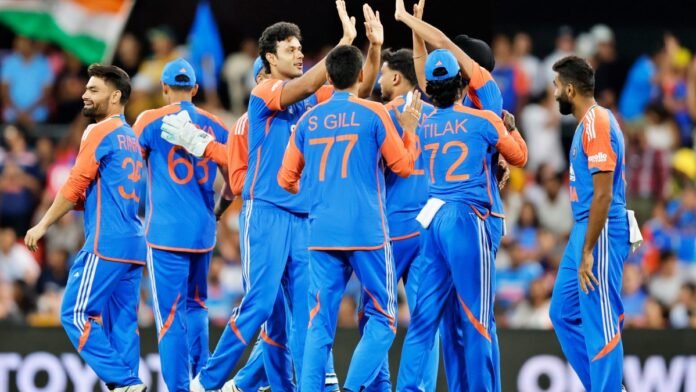
Key Points:
- India defeated Australia by 48 runs at Carrara Oval, Gold Coast on November 6, 2025
- India posted 167/8; Australia bowled out for 119 in 18.2 overs
- Series now stands 2-1 in India’s favor with one match remaining
- Axar Patel named Player of the Match for 21 runs and 2/20 bowling
- Washington Sundar’s 3/3 devastated Australia’s lower order; series now decisively in India’s grip
New Delhi: India’s comprehensive victory at Carrara Oval demonstrated the team’s growing confidence as the five-match series approaches its climax. After the opening fixture in Canberra was abandoned due to rain and Australia secured a four-wicket victory in Melbourne, India leveled the series with a thrilling 187-run chase in Hobart. The fourth T20I proved decisive in shifting the momentum decisively toward Suryakumar Yadav’s men. By winning this contest, India ensured they could not be defeated in the series heading into the final match, a psychological advantage that amplifies pressure on the Australian team.
The victory strengthens India’s position as the world’s No. 1 T20I team, demonstrating its ability to execute under varied conditions and against quality opposition. Australia’s collapse for 119 highlighted the fragility exposed when facing disciplined spin bowling and aggressive middle-order batting.
Steady Opening Partnership Builds Foundation
After Mitchell Marsh won the toss and elected to field, India’s opening pair of Shubman Gill and Abhishek Sharma provided the foundation for a competitive total. Gill scored a measured 46 runs from 39 deliveries, displaying renewed composure after struggling for form throughout the Australia tour. The vice-captain’s knock marked a significant improvement, breaking a concerning streak where he had failed to register a half-century across six consecutive matches, including scores of 10, 9, 24, and 15 in earlier tour fixtures.
Abhishek Sharma complemented Gill’s contribution with an aggressive 28 runs from 21 balls, combining stability with boundary-hitting prowess. The opening duo shared a 56-run partnership that propelled India to 75/1 by the halfway mark, establishing the foundation upon which later batters could flourish. Their combined approach, balancing caution and aggression, exemplifies modern T20 cricket principles.
Death Overs Fireworks: Dube and Patel Ignite the Middle Order
While middle-order batters struggled to convert starts into substantial scores, captain Suryakumar Yadav and all-rounder Axar Patel delivered crucial acceleration in the final overs. Suryakumar scored a quick-fire 20 runs from just 10 balls with a strike rate of 200, demonstrating the aggressive intent required in T20 cricket’s death phases. His quick cameo lifted the run-rate despite losing wickets at regular intervals.
Axar Patel then took center stage with an explosive 21 runs from only 11 deliveries, including multiple boundaries that pushed India past the 160-run mark. Though Shivam Dube’s contribution of 22 runs appeared modest, it added crucial runs during a phase when Australia’s bowlers threatened to restrict India excessively. The collective death-overs assault transformed a potentially modest total into a defendable 167/8.
Nathan Ellis and Adam Zampa Lead Australian Bowling Attack
Australia’s pace and spin attacks combined effectively during India’s innings, with Nathan Ellis and Adam Zampa each claiming three wickets. Ellis dismissed Shubman Gill, Shivam Dube, and Washington Sundar, exploiting varied pace and movement off the pitch. His spell of 3/21 represented disciplined bowling that threatened to severely restrict India’s total.
Adam Zampa’s three-wicket haul targeted India’s top order, dismissing openers Abhishek Sharma, Tilak Varma, and wicketkeeper Jitesh Sharma. The leg-spinner’s variations proved problematic for batters struggling with consistency throughout the tour. Xavier Bartlett and Marcus Stoinis each contributed one wicket, demonstrating balanced bowling contributions that kept India’s scoring in check.
Australia’s Chase Derails Rapidly: Sundar and Patel Orchestrate Collapse
Australia’s batting collapse in pursuit of 167 proved the decisive factor. Mitchell Marsh top-scored with 30 runs from 24 balls, combining aggression with some measured batting, while opener Matthew Short contributed 25 runs. However, no other Australian batsman reached double figures—a catastrophic batting performance that exposed the fragility of their middle order. The Kangaroo team reached only 119 all out in 18.2 overs, surrendering hope after losing early wickets.
Washington Sundar emerged as the match’s most destructive bowler, taking 3 wickets for just 3 runs in 1.2 overs, dismantling Australia’s lower order with clinical efficiency. His spell demonstrated the devastating potential of disciplined left-arm spin, particularly against batters with inadequate plans against turning deliveries. The figures of 3/3 represented exceptional bowling performance in T20 cricket, effectively ending the contest through sheer skill and execution.
Axar Patel’s All-Round Excellence Earns Player of the Match
Axar Patel’s combined performance of 21 runs and 2 wickets for 20 runs from four economical overs earned him the Player of the Match award. His disciplined bowling restricted Australia’s scoring despite limited opportunities to showcase aggressive batting. Patel’s versatility—excelling with both bat and ball exemplified modern all-rounder demands, proving invaluable in T20 cricket’s compressed format.
Beyond Sundar and Patel, Shivam Dube and Arshdeep Singh each contributed one wicket, while Jasprit Bumrah and Varun Chakravarthy added boundary-line pressure. India’s balanced bowling attack, combining pace and spin effectively, restricted Australia to an embarrassingly low total, demonstrating superior match-day execution.
Series Dynamics and Fifth Match Implications
India’s 2-1 series lead places them on the precipice of claiming the five-match trophy. With only one match remaining, India requires merely one point, a draw, or a victory to secure the series. This advantageous position generates significant psychological pressure on Australia, which must win the fifth T20I while hoping for Indian failure to force a decider. The final match at the same Carrara Oval venue promises decisive cricket where both teams will deploy maximum resources.
The series trajectory reflects India’s growth as a T20 force. Despite early setbacks and form concerns regarding captain Suryakumar Yadav and vice-captain Shubman Gill, the team demonstrated resilience and skill across varied conditions. Australia’s batting vulnerabilities, particularly in the middle order, remain a critical weakness heading into the final contest.
Tournament Context and T20 World Cup Preparation
This bilateral series carries heightened significance as preparation for the T20 World Cup, providing both teams with valuable match experience and tactical insights. India’s dominant performance in the fourth match reassures selectors about their squad’s depth and adaptability. The emergence of players like Axar Patel and Washington Sundar’s brilliant spin bowling contributions suggests India possesses multiple match-winning options across batting and bowling.
For Australia, the comprehensive loss raises concerns about batting depth and consistency against quality spin bowling. The middle-order fragility exposed at the Gold Coast must be addressed before international tournaments, where such vulnerabilities become magnified against stronger opposition.






















































